TEST OF THE
WATEC 120N VIDEO CAMERA
for
autoguiding and asteroid occultations applications
Cliquer ici
pour une version française ![]()
The camera tested is the model Watec 120N (CCIR version) equipped with a Sony CCD detector ICX-418ALL (1/2"). The specificity of the camera is the internal long exposure function. The camera allows a maximum integration time of 256 frames, i.e. about 10 seconds. The camera was tested the 18 Nov. 2005 in the author's suburban observatory (Castanet, near Toulouse, South of France) at the period of full moon (naked eye limit magnitude was around 3). The outside temperature was around 4°C. The camera was connected to a computer a GrabBeeX USB2 grabber interface. Iris software was used to digitize (frame by frame mode, not AVI acquisition) and processing.

From
left to right, the WAT-120N, the WAT-902H2, the WAT-902H.
The field observed is a well know
photometric area of the open cluster M67 (the "dipper asterism").
See
- M. Joner & B. Taylor, PASP 102, 1004 (1990)
- C. Chevalier and
S.A. Ilovaisky, A&AS, 90, 225, (1991)
No spectral filter used, therefore the results do not have a rigorous photometric value. They are only representative of the limits magnitude for application like asteroid occultation or autoguiding on faint objets.
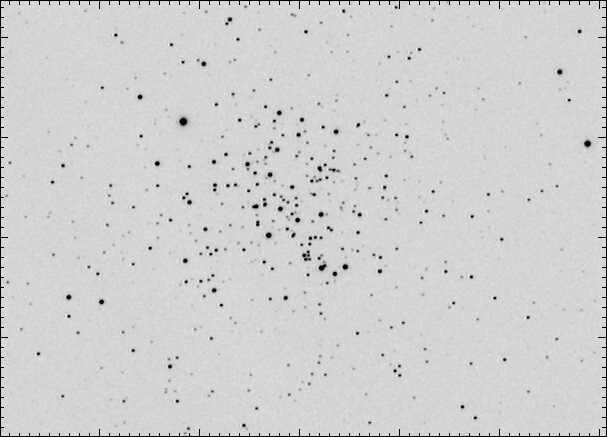
The
open cluster Messier 67. The "dipper asterism" is near the center
of the field. The north is up.
The image was obtained with a Takahashi
FSQ-106 refractor (10.6 cm aperture) and a Watec-120N video camera.
Addition
of 10 frames exposed each 10.24 s (256 internal stack mode) - mid-gain adjustment.

Detail
of the M67 "dipper asterism". The V magnitude of some stars is indicated.
Image
taken with a Celestron 11 telescope (28 cm aperture) at F/10 and a Watec-120N
camera.
Stack of 3 x 5.12 seconds exposure (128 internal stack).
The following images show the M67 field according the integration time taken with a Celestron 11 at F/10. The gain is adjusted at HI position. The thermal dark signal is subtracted (the master dark is the median of 20 individuals frames taken in the darkness with the given exposure time). The seeing is very bad during the observation, near 5 to 6 arcsec. Only the better resolved images are presented.
|
|
|
|
|
|
|
|
|
|
|
|
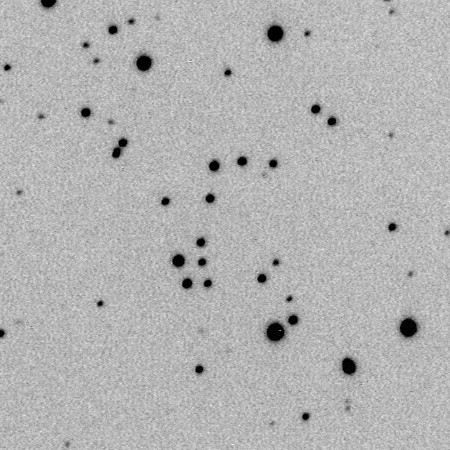
Single
shot exposed 10.24 second (256 internal stack)
The next table summarize the magnitude limit found. The reasonable magnitude is the detectivity limit magnitude minus 1.5, required for autoguiding and for observe with a minimal of precision the occultation of a star by an asteroid.
WAT-120N at the focus of a C11 telescope (D=28 cm)
|
Video rate (or exposure time) |
Limit V magnitude |
Reasonable V magnitude |
|
0.02 sec |
10.4 |
8.9 |
|
0.08 sec |
12.6 |
11.1 |
|
0.16 sec |
13.2 |
11.7 |
|
0.32 sec |
13.5 |
12.0 |
|
0.64 sec |
13.8 |
12.3 |
|
1.28 sec |
14.5 |
13.0 |
|
2.56 sec |
15.1 |
13.6 |
|
5.12 sec |
15.4 |
13.9 |
|
10.24 sec |
15.7 |
14.2 |
Same table, but for a FSQ-106 refractor:
WAT-120N at the focus of a FSQ-106 refractor (D=10.6 cm)
|
Video rate (or exposure time) |
Limit V magnitude |
Reasonable V magnitude |
|
0.08 sec |
10.5 |
9.0 |
|
0.16 sec |
11.4 |
9.9 |
|
0.32 sec |
13.1 |
11.6 |
|
1.28 sec |
13.8 |
12.3 |
|
2.56 sec |
14.1 |
12.6 |
Comparison of the Watec 120N and the Watec 902H / Watec 902H2
The WAT-902H and WAT-902H2 (supreme) are sensitive "standard" video. Only the TV vidéo rate is available.
The M67 field is observed with the Watec 902H and the Watec 902H2 at the focus of a Celestron 11:
|
|
|
First conclusion: A Hi AGC is not a good idea
for stellar imagery because the increase of the background noise (for identical
settings the 902H and 902H2 performances are very similar).
Second conclusion:
The detectivity of the WAT-902H and the WAT-120N are nearly identical if the
latter is adjusted to the exposure time of 0.08 second, see below:
|
|
|
About Deep-Sky observations
The thermal signal correction
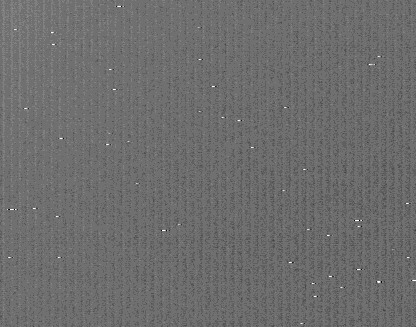
The
median stack of 10 individual frames exposed each 10.24 s in the darkness (256
internal stack mode - mid-gain).
Note a fixed pattern and the presence
of the hot pixels. The image is named the master
dark frame.
|
|
|
The origin of the vertical parasitic structures is probably the frame grabber because the level of the phenomenon is independent of the Watec camera gain. The quality of grabber is essential for the final result. Some devices can have qualities higher than others. The type of interface can also have an importance: here an USB interface, but it is possible to find PCMCIA cards (IMPERX grabber for example). Some camcorder can be used via the s-video input/output.
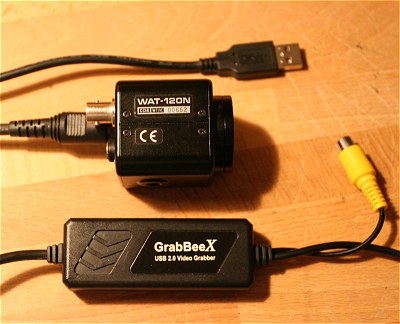
The
grabber model used for the tests.
For the same model of grabber, the result can
be different from a serial number to an other... see below the very high contrasted
images (typical RMS noise of only 0.4 ADU) of the bias signal for the same WAT-120N,
digitized with three distincts GrabeeX devices (median sum of 20 successives
frames):
|
|
|
|
Important note
Put always the GAMMA switch at position OFF. It is required for image processing. In the contrary case, the correction of the thermal dark current is not effective.
|
|
|
The best solution for attenuate the fixed pattern if it is present, is to shift the pointing direction of the telescope between each image (diphering technique). By simple average effect, the pattern is erased during the stacking (and after registration of course).
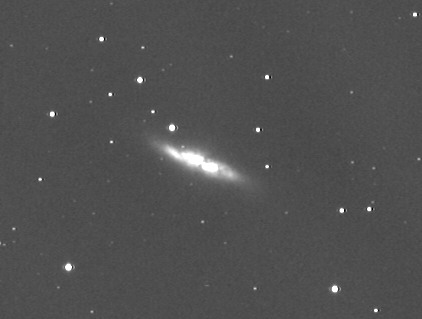
Stack
of 30 x 10.24 s diphered images (256 internal stack mode). Gain at mid-position.
FSQ-106
refractor. Suburban conditions.
|
|
If the fixed pattern is definitively present in the processed image, frequency filtering in the Fourier domain can be the last help solution...
|
|
|
|
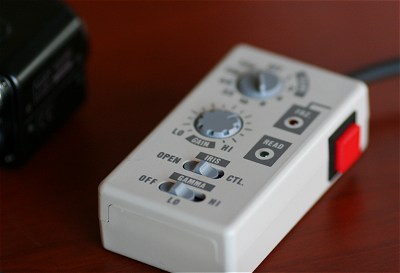
The
Watec 120N control box.
Some applications
Faint star autoguider for spectrograph
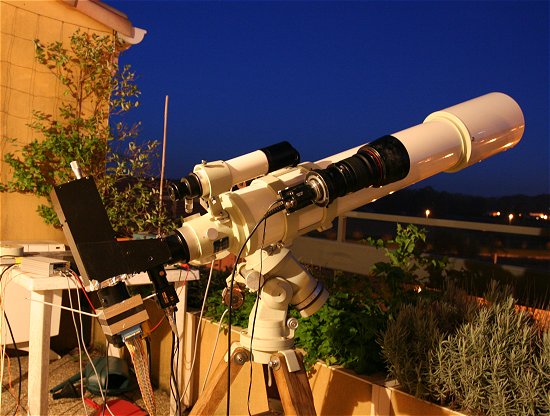
The
WAT-120N
used for center and guiding star on the entrance slit of a LHIRES spectrograph.
A camera WAT-902H + a telephoto lens are used as an electronic finder.
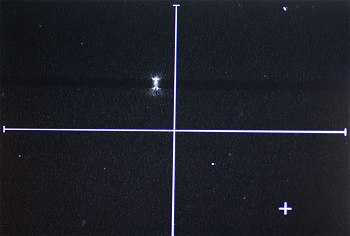
Star
autoguiding with the WAT-120N. The entrance slit is the faint horizontal dark
line.
Scan the sun surface
Spectroheliographic
mode of LHIRES
|
|
|